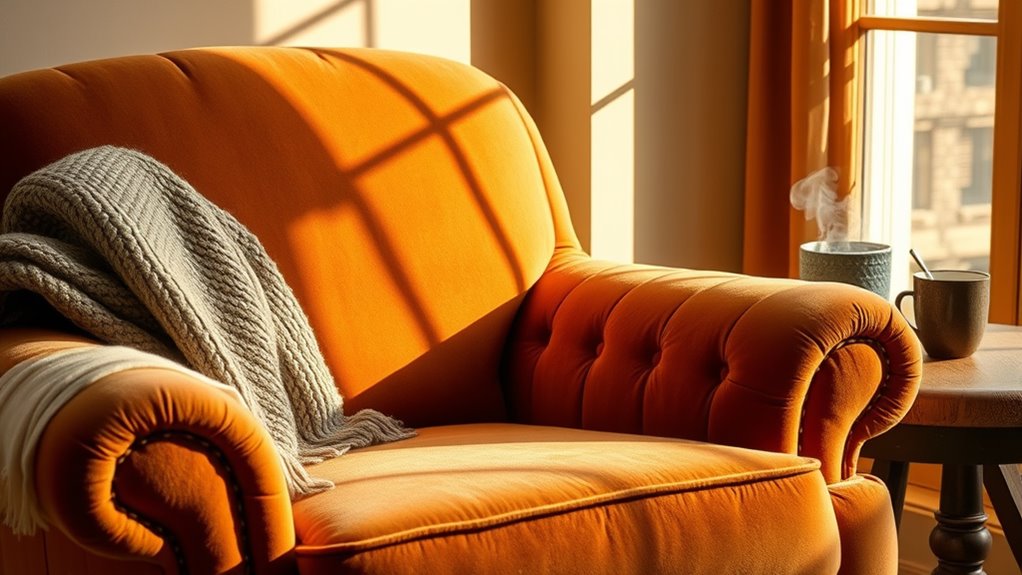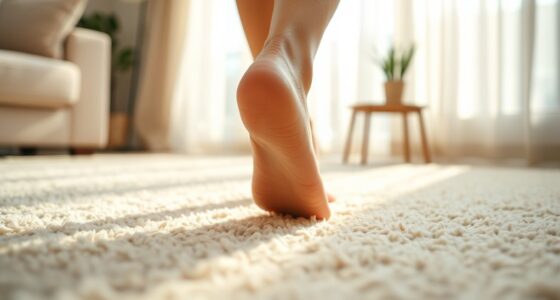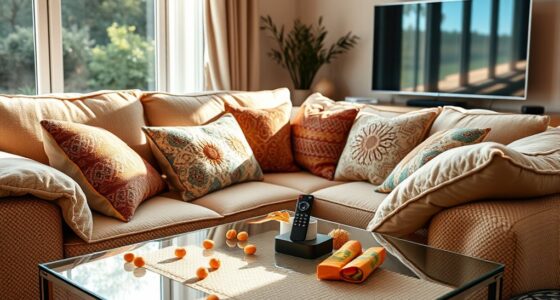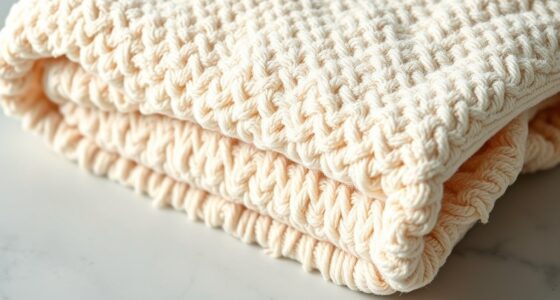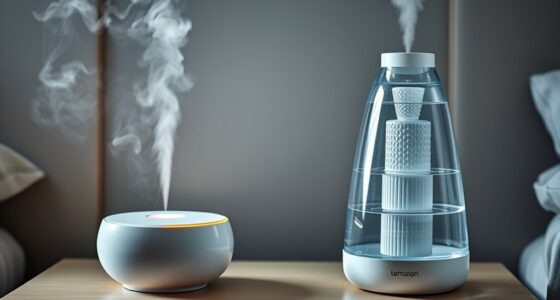When you sit in a cozy, supportive chair, your brain receives signals of safety through sensory cues like softness, warmth, and gentle textures. These cues trigger physical relaxation by reducing stress hormones like cortisol and encouraging a calm, stability-inducing response. Proper support also improves posture and circulation, enhancing overall comfort. By understanding how these factors work together to promote quick relaxation, you’ll discover even more ways to create spaces that help you unwind effortlessly.
Key Takeaways
- Cozy chairs provide tactile comfort with soft textures and warmth, triggering calming sensory responses.
- Proper ergonomic support maintains spinal alignment, reducing muscle tension and promoting relaxation.
- Warm lighting and calming scents enhance mood and signal safety, accelerating stress relief.
- Supportive furniture improves blood flow, delivering oxygen and nutrients that foster calmness.
- Familiar, cozy environments activate the brain’s relaxation pathways, reducing stress hormones like cortisol.
The Psychological Power of Comfort
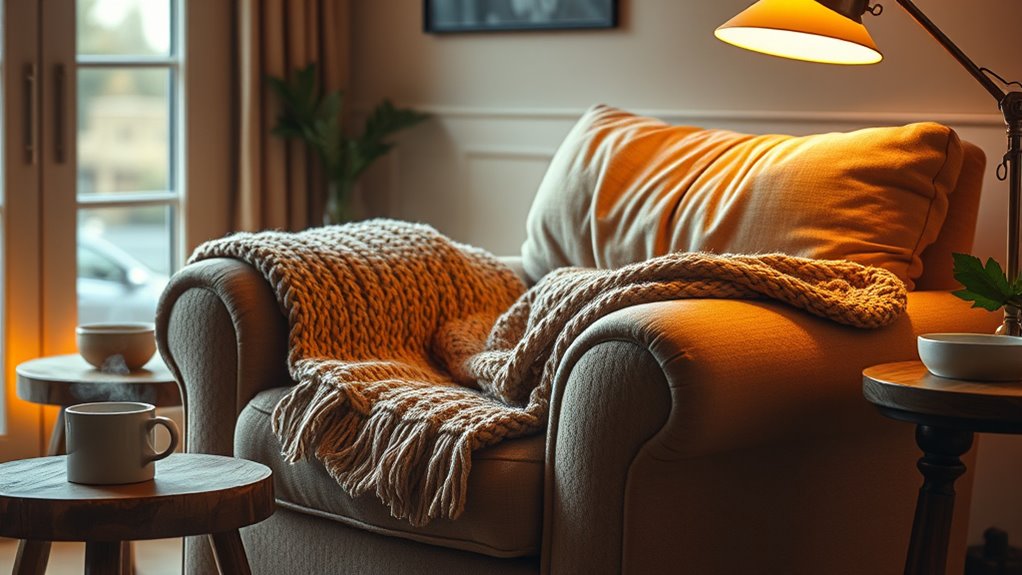
Comfort has a remarkable ability to influence your mental state, providing immediate relief from stress and anxiety. When you feel emotionally comforted, your brain releases feel-good chemicals that promote calmness and stability. This sense of psychological safety helps you feel secure, reducing feelings of vulnerability or threat. As you settle into a cozy chair, you may notice your worries fade, replaced by a sense of peace. Emotional comfort creates a safe mental space where you can relax fully, knowing you’re protected from external pressures. Color accuracy impacts the overall image quality, subtly influencing how comfortable you feel during a movie or gaming session. This mental safety is essential for restoring balance and fostering resilience. The simple act of experiencing comfort can strengthen your emotional well-being, making everyday stressors easier to manage and helping you feel more grounded.
How Supportive Furniture Affects Stress Reduction
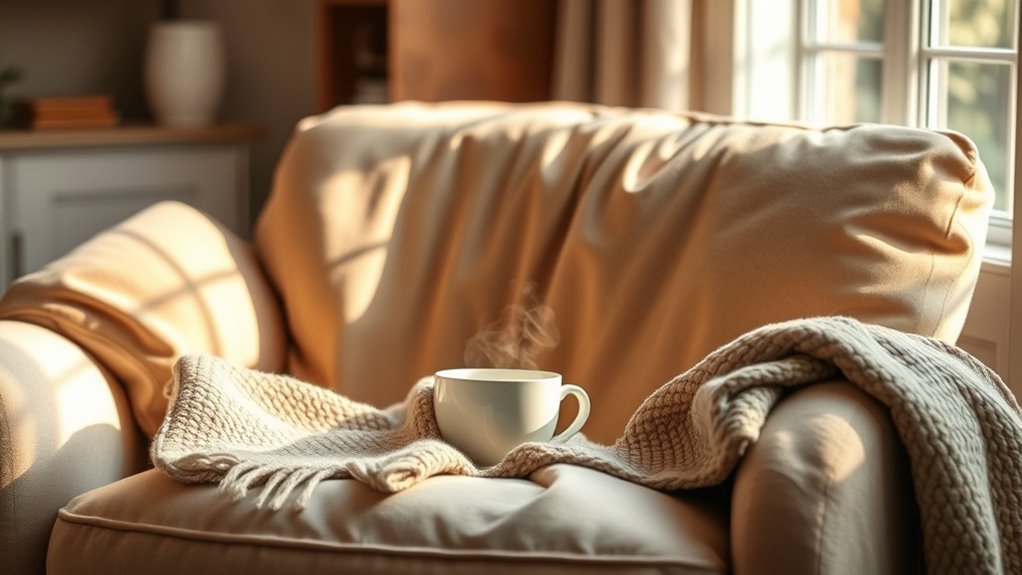
When you sit on supportive furniture, your spine stays properly aligned, reducing tension in your muscles and joints. This comfort encourages better blood flow, helping your body relax more easily. As a result, your stress levels can drop, making it easier to unwind and feel calm. Incorporating self-watering plant pots into your space can also contribute to a sense of tranquility by maintaining a healthy environment.
Proper Spinal Alignment
Proper spinal alignment plays an essential role in reducing stress and promoting overall well-being, especially when supported by the right furniture. An ergonomic design ensures your chair encourages proper posture, preventing strain and discomfort. Lumbar support is indispensable, as it maintains the natural curve of your lower back, reducing tension and promoting relaxation. When your spine aligns correctly, you breathe more easily, and your muscles don’t have to work overtime to compensate. This minimizes fatigue and helps you feel calmer faster. Choosing furniture with good ergonomic features and proper lumbar support isn’t just about comfort; it’s a key factor in lowering stress levels and fostering a sense of ease during your downtime. Correct spinal alignment ultimately helps you relax more deeply and recover more efficiently. Proper ergonomic design can also prevent long-term health issues related to poor posture.
Enhanced Blood Flow
Supportive furniture plays a crucial role in enhancing blood flow, which directly influences stress reduction. When your chair features ergonomic design, it encourages proper circulation by reducing pressure points and supporting healthy posture. This means your blood can flow more freely, delivering oxygen and nutrients to your muscles and brain, helping you feel calmer and more alert. Additionally, the material breathability of your furniture matters; breathable fabrics prevent overheating and moisture buildup, keeping you comfortable over extended periods. When you sit in such supportive furniture, your body doesn’t have to work extra to stay comfortable, which lowers stress levels. Improved blood flow not only promotes relaxation but also reduces tension, making your cozy chair a key factor in fostering a sense of calm. Incorporating supportive furniture into your space aligns with Fokos principles by prioritizing comfort and well-being.
The Role of Sensory Cues in Relaxation

Your senses play a big role in helping you relax; textures and warmth make your environment feel inviting. Pleasant scents and calming sounds can quickly shift your mood, easing tension and promoting comfort. By understanding these cues, you can craft a space that naturally encourages relaxation. For example, incorporating dog breeds with calming temperaments, like Golden Retrievers or Doxie-Poodle mixes, can enhance the soothing atmosphere of your environment.
Texture and Warmth
Texture and warmth play a crucial role in creating a sense of relaxation because they engage your senses in a comforting way. The feel of fabric textures, like soft velvet or plush fleece, can instantly signal safety and coziness. When you sit in a chair with high thermal comfort, your body feels more at ease, reducing stress and promoting relaxation. Warmth from materials mimics the sensation of being wrapped in a gentle hug, triggering a calming response. The tactile experience of smooth, inviting textiles helps your mind shift away from tension. By choosing fabrics that feel pleasant against your skin and provide cozy warmth, you create an environment that encourages you to unwind and feel safe. Additionally, the comfort of celebrity-inspired interior design emphasizes the importance of tactile textures in creating relaxing spaces. Texture and warmth are essential sensory cues that foster immediate relaxation.
Scent and Sound
Scent and sound deeply influence how relaxed you feel in an environment. Aromatherapy benefits, like lavender or chamomile, can calm your mind and reduce stress quickly. The right soundscape design creates a soothing backdrop, helping your body unwind. When you incorporate gentle scents and calming sounds, your nervous system shifts toward relaxation. Imagine soft melodies paired with subtle floral aromas—each sensory cue working together to deepen your comfort. These elements evoke feelings of safety, tranquility, and warmth. By intentionally choosing calming scents and harmonious sounds, you enhance your cozy experience, making it easier to slip into a restful state. Additionally, understanding the neurobiological effects of sensory cues can help tailor environments for maximum relaxation. Essentially, scent and sound are powerful tools that transform your space into a sanctuary of serenity.
The Science Behind the Feeling of Security
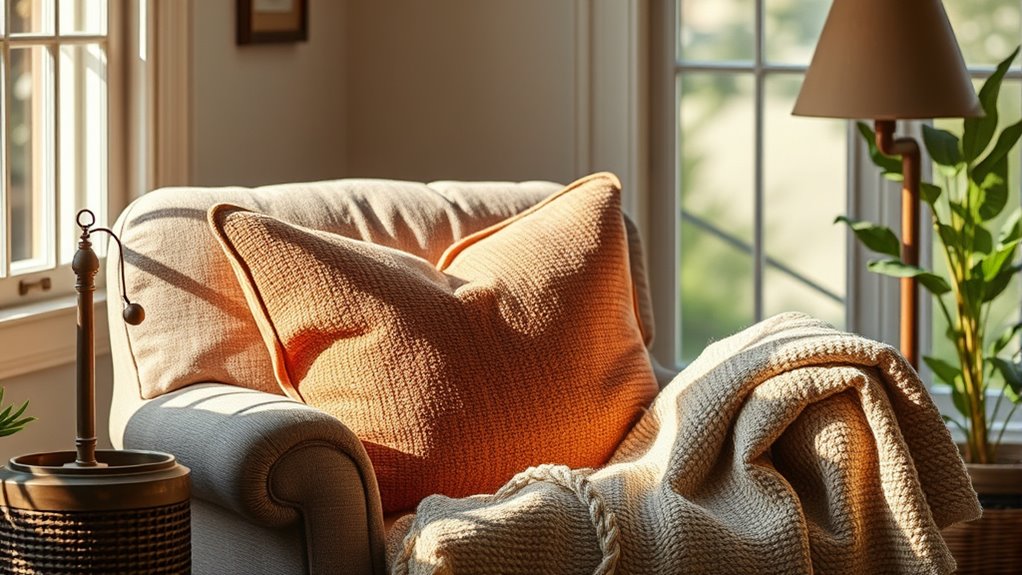
The feeling of security triggers a complex interplay of psychological and physiological responses in your brain, creating a sense of calm and stability. When you’re in a cosy ambiance, your security instinct kicks in, signaling that you’re safe. This reduces stress hormones like cortisol and activates calming pathways, helping you relax faster. Your brain associates certain cues—soft lighting, familiar surroundings, or a comfortable chair—with safety, reinforcing this feeling. This sense of security encourages your body to lower heart rate and relax muscles, making you feel more at ease. Additionally, emotional comfort plays a crucial role in fostering a sense of well-being, further enhancing relaxation. Fundamentally, your brain interprets the cozy environment as a safe space, triggering natural relaxation responses that make it easier to unwind and fully enjoy your comfort zone.
Physical Benefits of a Cozy Seating Environment
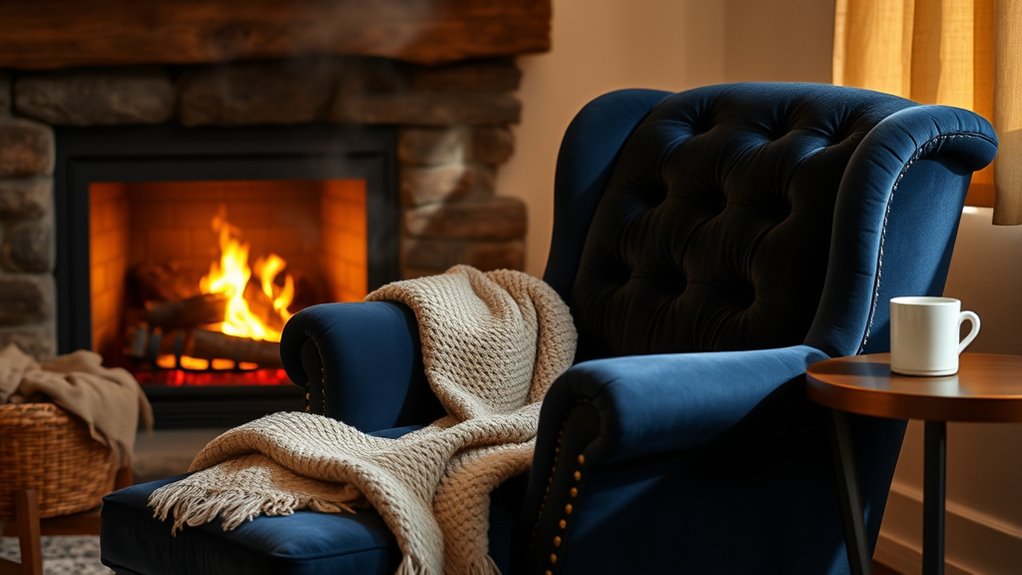
A cozy seating environment not only fosters mental relaxation but also provides tangible physical benefits. When you choose chairs with ergonomic design, you support proper posture, reducing strain on your back and neck. Durable materials ensure your seat remains comfortable and supportive over time, preventing sagging and discomfort. This combination helps decrease muscle tension and improves circulation, making you feel more energized after sitting. Additionally, a well-designed, sturdy chair minimizes the risk of injury from falls or poor support. Investing in ergonomic, durable furniture encourages better body alignment and less physical stress, allowing you to relax deeply without worry. Creating a space with these qualities promotes not only comfort but also long-term physical well-being.
The Impact of Warmth and Softness on Mood
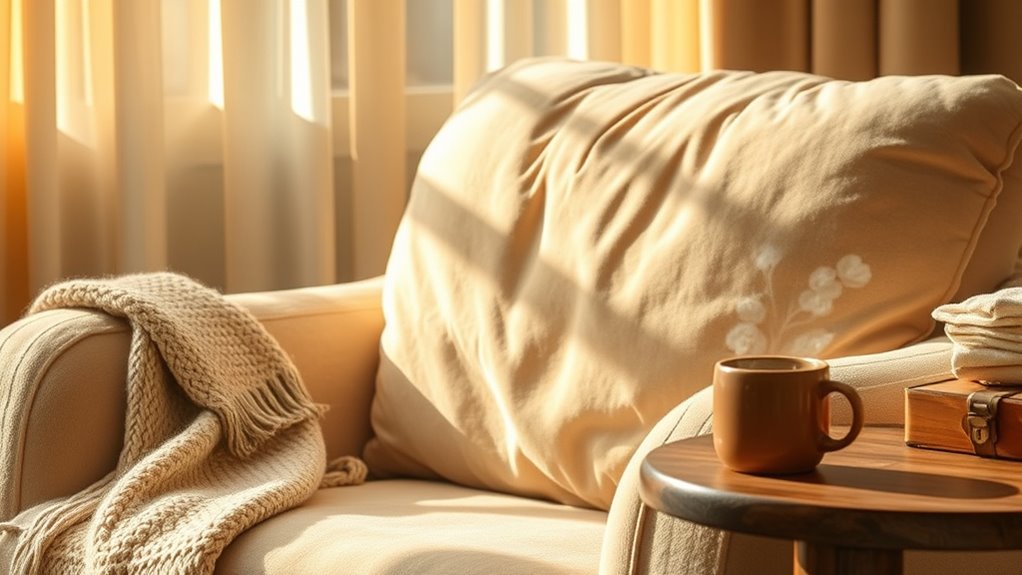
Warmth and softness can considerably boost your mood by creating an inviting, secure environment. When your space offers effective thermal insulation, it helps maintain consistent warmth, making you feel comfortable and protected. Soft fabrics with pleasant textures enhance this effect by engaging your sense of touch, which can trigger feelings of relaxation and happiness. The tactile sensation of plush cushions or cozy blankets fosters a sense of safety, reducing stress and anxiety. When your environment feels warm and soft, your brain associates it with comfort and security, naturally lifting your mood. This combination of thermal insulation and inviting fabric textures activates positive emotional responses, reinforcing your desire to unwind and relax in your favorite cozy spot. Additionally, incorporating natural elements such as plants can improve air quality and further enhance feelings of well-being, creating a more biodiverse and calming space.
Environmental Factors That Enhance Relaxation

Creating an environment that fosters relaxation involves more than just comfort; it requires intentional choices about lighting, scent, and sound. Your lighting ambiance sets the mood, so opt for soft, warm lights that invite calm. Color psychology plays a crucial role; gentle hues like blues and greens promote tranquility, while muted earth tones create a cozy feel. To enhance relaxation, consider these elements:
- Dim the lights to create a soothing glow
- Use warm-colored decor that evokes safety and peace
- Incorporate calming scents like lavender or chamomile
- Play gentle background sounds or nature noises
- Ensuring your space is free from mold and spoilage can prevent discomfort and promote a truly relaxing environment bad lemon juice.
The Connection Between Comfort and Cortisol Levels
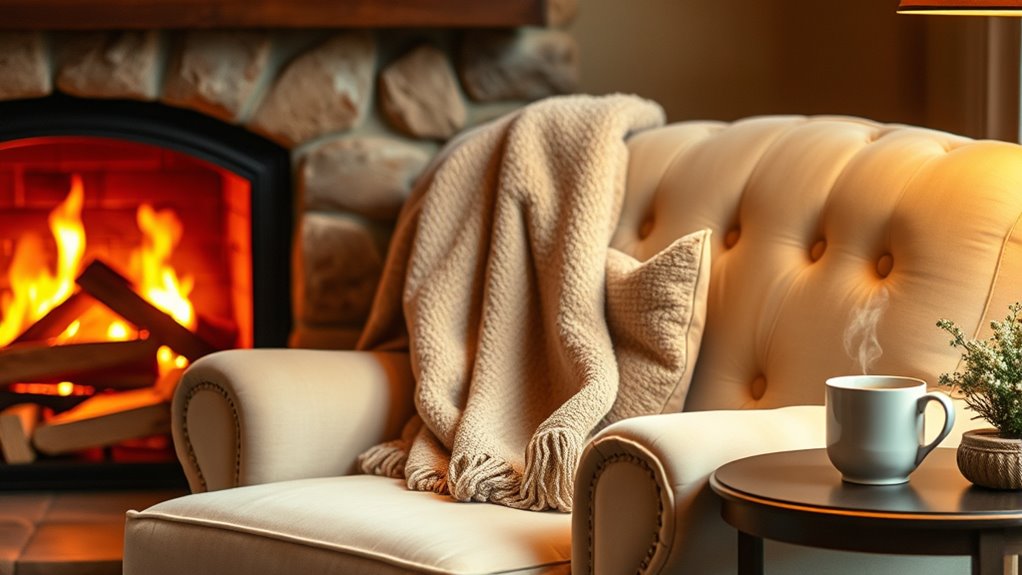
Have you ever wondered how comfort directly impacts your stress levels? When you settle into a cozy chair, your body activates the relaxation response, which lowers stress hormones like cortisol. This decrease in cortisol helps your body recover from daily pressures and reduces feelings of anxiety. Comfort creates a calming environment that signals your brain to relax, dampening the production of stress hormones. As your stress hormones drop, you feel more at ease and less overwhelmed. This connection explains why a comfy space can be so effective at promoting relaxation. When you prioritize comfort, you’re not just feeling good—you’re actively reducing the physiological effects of stress, making it easier to unwind and restore balance in your body.
Practical Tips for Creating Your Own Relaxing Space
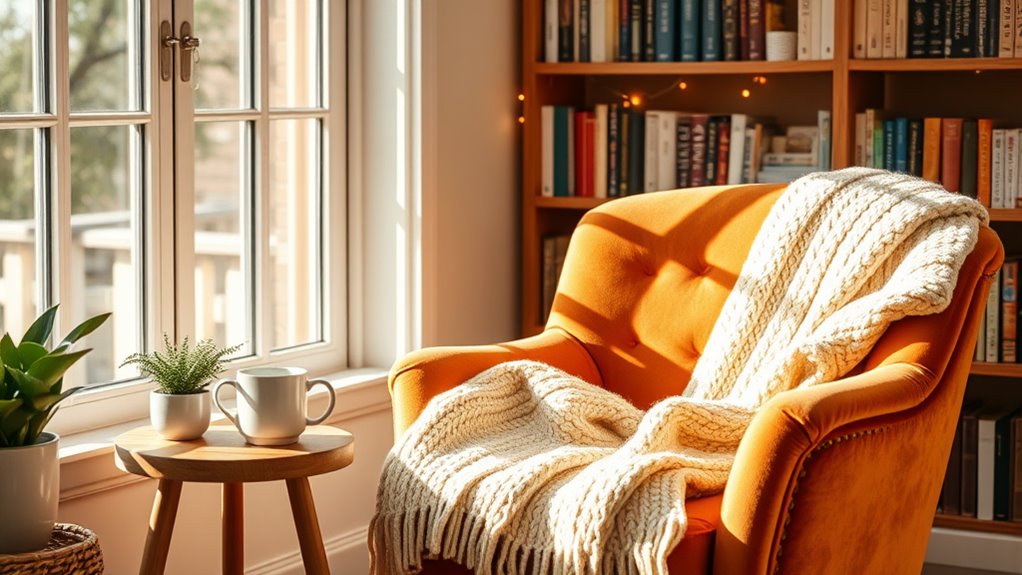
To transform any space into a calming retreat, start by choosing comfortable furniture that invites you to sit or lie down without strain. Personal decor plays a crucial role—add cherished items, photos, or textiles that evoke positive memories and feelings. Pay attention to lighting ambiance; soft, warm lights create a soothing atmosphere, while dimming switches help you unwind. Keep clutter to a minimum, allowing your mind to relax fully. Incorporate calming scents like lavender or chamomile to enhance the environment. Use cozy textiles such as plush blankets and cushions to increase comfort. These simple adjustments make your space more inviting, encouraging you to relax deeply and recharge faster. Your personal sanctuary becomes a true haven for rest and rejuvenation.
Frequently Asked Questions
How Does Posture Influence Feelings of Relaxation and Comfort?
Your posture considerably influences how relaxed and comfortable you feel. By practicing posture awareness, you can reduce tension and promote relaxation. Ergonomic design in chairs supports natural alignment, helping you maintain a comfortable stance without strain. When you sit correctly, your body releases stress, making it easier to unwind. So, paying attention to your posture and choosing ergonomic furniture can boost your comfort and help you relax faster.
Can Personalized Scents Improve Relaxation in Cozy Environments?
Imagine your senses as a magic key opening a door to calm. Personalized scents, through scent memory and aroma therapy, can be that key, transforming your cozy space into a sanctuary. When you choose fragrances that resonate with positive memories, they enhance relaxation and comfort. This tailored approach helps your mind associate specific aromas with peace, making it easier to unwind and fully enjoy your cozy environment.
What Role Does Lighting Play in Enhancing Comfort and Reducing Stress?
Lighting plays a vital role in creating a comfortable environment and reducing stress. You can enhance your space with ambient illumination that softly lights the room without harsh glare. Mood enhancing bulbs further improve your mood by providing warm, soothing light that relaxes your mind. When you choose the right lighting, you make your environment more inviting and calming, helping you unwind and feel more at ease in your space.
How Quickly Can a Comfortable Space Affect Cortisol Levels?
Imagine your stress melting away faster than ice cream on a hot day. A cozy space can start lowering cortisol levels within minutes, thanks to its calming effect. As you sink into comfort, your body shifts into relaxation mode, promoting stress reduction and cortisol regulation. So, in just a short while, your environment can work wonders, turning chaos into calm and helping you feel better almost instantly.
Are There Cultural Differences in Perceptions of Cozy and Comfort?
You might notice that cultural comfort and perception differences influence how cozy spaces are viewed worldwide. In some cultures, a simple, warm environment signifies comfort, while others associate coziness with specific furniture or rituals. These perception differences shape what you find relaxing, making the idea of comfort truly personal. Recognizing these cultural variations helps you understand that coziness isn’t universal—it’s shaped by your background and societal norms.
Conclusion
Creating a cozy space isn’t just about comfort; it can actually lower your stress levels. Did you know that relaxing in a supportive chair can reduce cortisol, the stress hormone, by up to 20%? When you surround yourself with warmth, softness, and familiar sensory cues, you trigger your brain’s relaxation response. So, invest in your comfort zone—you’ll feel calmer faster and enjoy better overall well-being every time you sit down.
